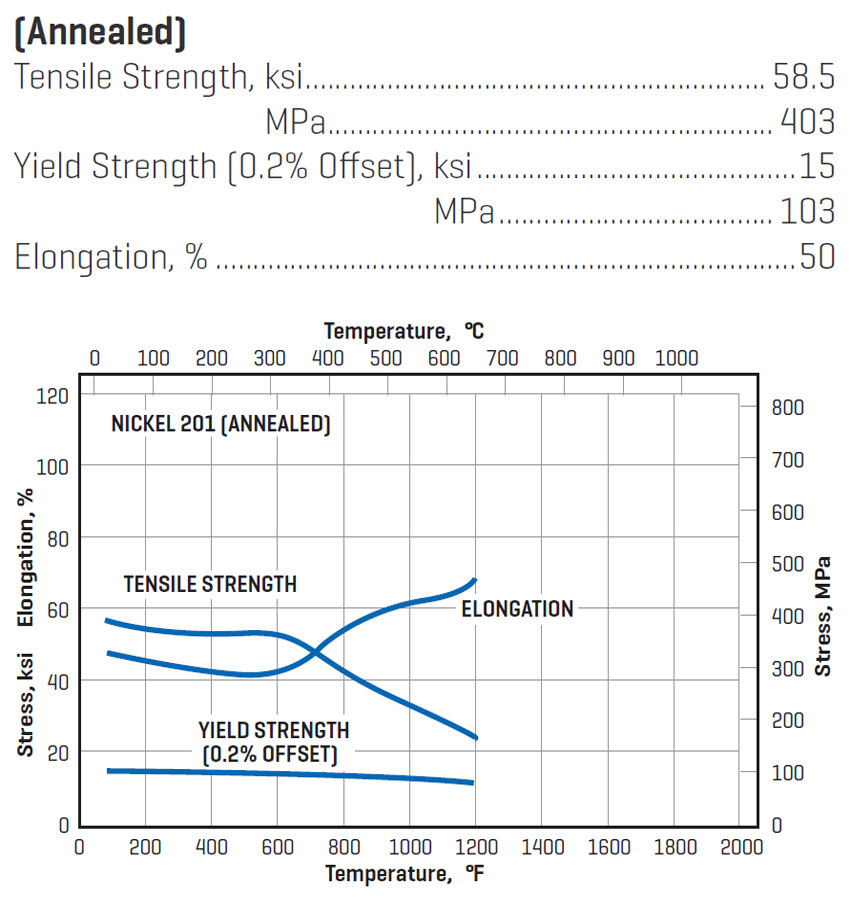Product Description
Commercially pure (99.6%) wrought nickel essentially the same as Nickel 200 but with a lower carbon content to prevent embrittlement by intergranular carbon at temperatures over 600°F (315°C). Lower carbon content
also reduces hardness, making Nickel 201 particularly suitable for cold-formed items.
also reduces hardness, making Nickel 201 particularly suitable for cold-formed items.
STANDARD PRODUCT FORMS
Pipe, tube, sheet, strip, plate, round bar, flat bar, forging
stock, hexagon and wire.
stock, hexagon and wire.
MAJOR SPECIFICATIONS
UNS N02201
BS 3072 – 3074 (NA12)
ASTM B 160 – B 163, B 366,
B 725, B 730, B 751,
B 775, B 829
ASME SB-160 – SB-163,
SB-366, SB-725, SB-730,
SB-751, SB-775, SB-829
ASME Code Case 2249
SAE AMS 5553
DIN 17740, 17750 – 17754
Werkstoff Nr. 2.4061, 2.4068
VdTÜV 345
ISO 6207, 6208, 9723 – 9725
BS 3072 – 3074 (NA12)
ASTM B 160 – B 163, B 366,
B 725, B 730, B 751,
B 775, B 829
ASME SB-160 – SB-163,
SB-366, SB-725, SB-730,
SB-751, SB-775, SB-829
ASME Code Case 2249
SAE AMS 5553
DIN 17740, 17750 – 17754
Werkstoff Nr. 2.4061, 2.4068
VdTÜV 345
ISO 6207, 6208, 9723 – 9725
LIMITING CHEMICAL COMPOSITION, %
Nia..........99.0 min.
Cu........0.25 max.
Fe.........0.40 max.
aPlus Co.
Mn........0.35 max.
C...........0.02 max.
Si..........0.35 max.
S...........0.01 max.
Cu........0.25 max.
Fe.........0.40 max.
aPlus Co.
Mn........0.35 max.
C...........0.02 max.
Si..........0.35 max.
S...........0.01 max.
PHYSICAL CONSTANTS AND THERMAL PROPERTIES
Density, Ib/in3.........................................................................0.321
g/cm3......................................................................... 8.89
Melting Range, °F....................................................2615 – 2635
°C....................................................1435 – 1446
Specific Heat, Btu/lb•°F.....................................................0.109
J/kg•°C............................................................ 456
Curie Temperature, °F............................................................ 680
°C............................................................ 360
Permeability......................................................... Ferromagnetic
Coefficient of Expansion, 70 – 200°F, 10-6 in/in •°F........ 7.3
21 – 93°C, μm/m • °C............. 13.1
Thermal Conductivity, Btu • in/ft2•h•°F............................ 550
W/m • °C.......................................... 79.3
Electrical Resistivity, ohm •circ mil/ft...................................51
μΩ•m...............................................0.085
g/cm3......................................................................... 8.89
Melting Range, °F....................................................2615 – 2635
°C....................................................1435 – 1446
Specific Heat, Btu/lb•°F.....................................................0.109
J/kg•°C............................................................ 456
Curie Temperature, °F............................................................ 680
°C............................................................ 360
Permeability......................................................... Ferromagnetic
Coefficient of Expansion, 70 – 200°F, 10-6 in/in •°F........ 7.3
21 – 93°C, μm/m • °C............. 13.1
Thermal Conductivity, Btu • in/ft2•h•°F............................ 550
W/m • °C.......................................... 79.3
Electrical Resistivity, ohm •circ mil/ft...................................51
μΩ•m...............................................0.085
TYPICAL MECHANICAL PROPERTIES

previous
next
previous
next
Key words:
nickel
deg
ndash
bull
max.
in
carbon
bar
thermal
Related Products
Online message








